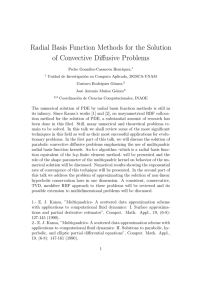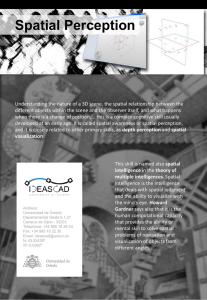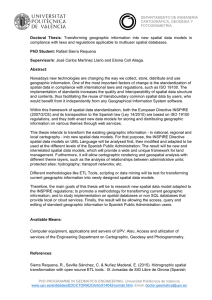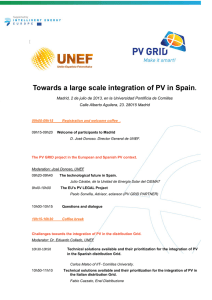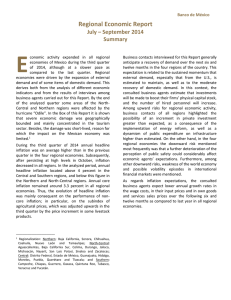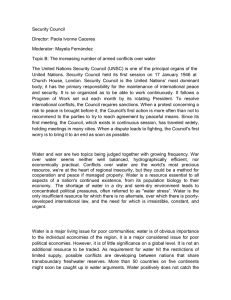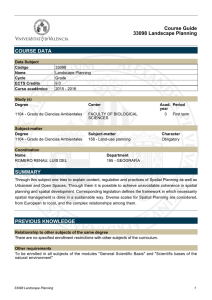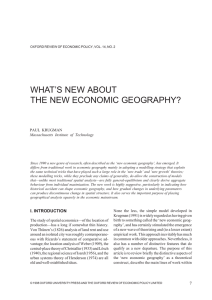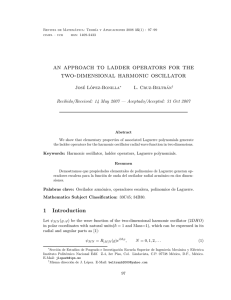TRANSPORTATION NETWORKS AND THE LOCATION OF HUMAN ACTIVITIES
Anuncio
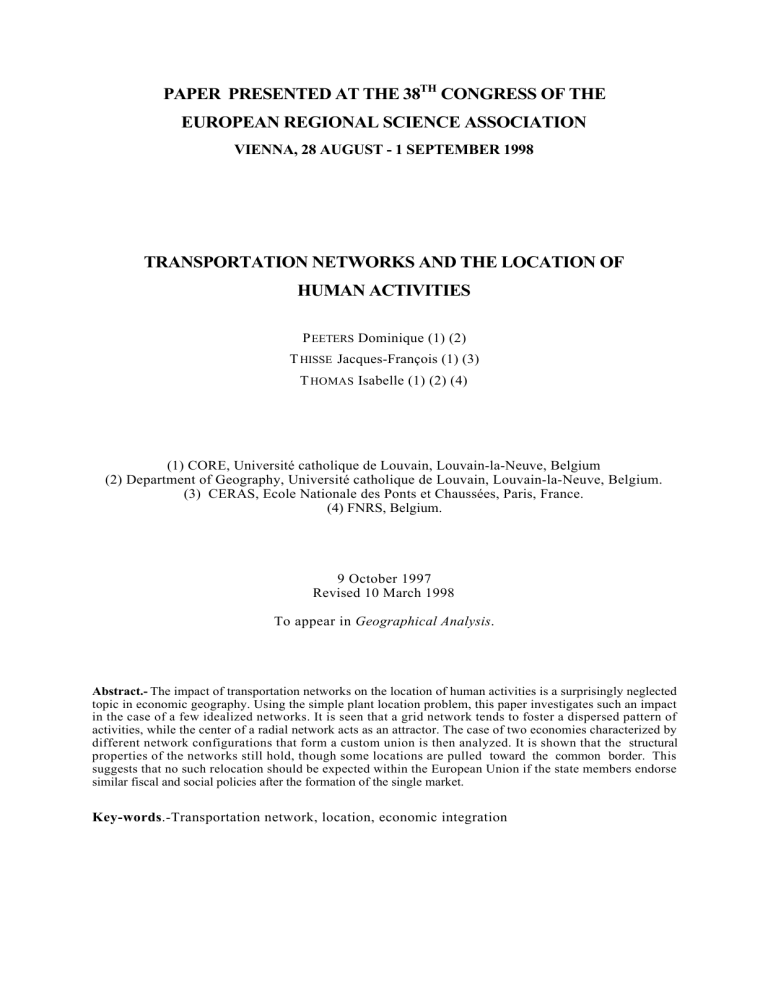
PAPER PRESENTED AT THE 38TH CONGRESS OF THE
EUROPEAN REGIONAL SCIENCE ASSOCIATION
VIENNA, 28 AUGUST - 1 SEPTEMBER 1998
TRANSPORTATION NETWORKS AND THE LOCATION OF
HUMAN ACTIVITIES
P EETERS Dominique (1) (2)
T HISSE Jacques-François (1) (3)
T HOMAS Isabelle (1) (2) (4)
(1) CORE, Université catholique de Louvain, Louvain-la-Neuve, Belgium
(2) Department of Geography, Université catholique de Louvain, Louvain-la-Neuve, Belgium.
(3) CERAS, Ecole Nationale des Ponts et Chaussées, Paris, France.
(4) FNRS, Belgium.
9 October 1997
Revised 10 March 1998
To appear in Geographical Analysis.
Abstract.- The impact of transportation networks on the location of human activities is a surprisingly neglected
topic in economic geography. Using the simple plant location problem, this paper investigates such an impact
in the case of a few idealized networks. It is seen that a grid network tends to foster a dispersed pattern of
activities, while the center of a radial network acts as an attractor. The case of two economies characterized by
different network configurations that form a custom union is then analyzed. It is shown that the structural
properties of the networks still hold, though some locations are pulled toward the common border. This
suggests that no such relocation should be expected within the European Union if the state members endorse
similar fiscal and social policies after the formation of the single market.
Key-words.-Transportation network, location, economic integration
1. Introduction
Transportation infrastructure is considered as one of the main instruments of the tool box
of spatial planners (Haggett and Chorley, 1972; Taaffe, Gauthier and O’Kelly, 1996). Many
decision makers interested in the role of transportation infrastructure take it for granted that
more infrastructure is always better than less because it would lead to less congestion and/or to a
higher accessibility to existing facilities. In fact, the relationships between the provision of
transport infrastructure and the level and distribution of human activities is complex, and can be
addressed from different perspectives. First, one may wonder what is the link between the
provision of infrastructure and the rate of economic growth? Second, one may also ask what is
the influence of a transport infrastructure on the attractiveness of a given area in which the
infrastructure is built up? In this paper, we focus on a third question: what is the impact (if any) of
the shape of the transport infrastructure on the geographical distribution of activities? To do so,
we take the level of activity as given and study the geographical distribution of facilities within
various network-types.
This facet of the problem has not been much studied (see, however, Peeters and Thomas,
1995, as well as Arnold, Peeters and Thomas, 1997, for two exceptions). The overwhelming
majority of contributions disregard the impact of (re)shaping the transport system on the
locational pattern of human activities. Either space is modeled as being one-dimensional, or the
shape of the network is given. Neither approach assesses the impact of the network shape (see
Aoyagi and Okabe, 1993, for a related criticism). Yet, in facility location analysis, it has been
shown that the choice of a particular metric to model distance leads to quite different locational
patterns (Beckmann and Thisse, 1986). Furthermore, the Hakimi theorem establishes that the
search for a cost-minimizing location along a network may be limited to the vertices of the
network, thus showing that the facility location depends on where the nodes are (Handler and
Mirchandani, 1979). These results are clear indications that the shape of the transport network is
likely to have a significant impact on the location of facilities. Finally, the empirical evidence
collected by Plassard (1976) about France and Italy reveals that new settlements arise only at the
highway nodes, thus confirming what the Hakimi theorem suggests.
In order to gain more insights about the impact of transportation policy on the spatial
pattern of facilities, we consider different types of toy-networks and study how the number and
the locations of facilities are affected by the difference in the transport system. More precisely,
we focus on the simple plant location problem, the purpose of which is to find the number and
locations of (public or private) facilities in order to minimize the sum of the fixed production
costs associated with the setting up of facilities and of the transport costs of users to the facilities
to be located. This model is one of the prominent location problems studied in facility location
analysis and very efficient algorithms have been designed to solve it (see Cornuejols, Nemhauser
and Wolsey, 1990, and Labbé, Peeters and Thisse, 1995, for recent surveys).
-1-
The simple plant location problem focuses on the trade-off between fixed production costs
and transportation costs. This trade-off is at the heart of many location models (Beckmann and
Thisse, 1986; Mulligan, 1984) and may be encountered in planning a system of public facilities,
such as schools or recreational facilities, as well as in the design of a production-distributionmarketing strategy by a private firm (Erlenkotter, 1977). Observe also that this trade-off is
central in economic geography where it appears in the pioneering analyses developed by
Christaller (1933) and Lösch (1940). On one hand, the existence of scale economies at the firms'
level is a critical factor for explaining the emergence of economic agglomerations. On the other
hand, the need to interact among individuals and the corresponding congestion costs (defined
broadly in order to include competition for land use), imply that all activities are generally not
concentrated in one place. Consequently, it is fair to say that the trade-off between scale
economies in production and transportation costs is critical for the geography of human
activities, and so regardless of the particular institutional setting in which those activities develop
(see Fujita and Thisse, 1996, for a more detailed discussion). This explains why we have chosen to
work in this paper with a model focusing on that trade-off.
One may wonder why we have retained the simple plant location problem. There are at
least two good reasons for that. First, for any given spatial distribution of demand, the solution to
this problem gives us the socially optimal configuration of facilities. Hence, it is likely that our
results shed light on what could be the ideal network design policy. Second, to the extent that the
market economy yields outcomes that are (more or less) socially optimal, the solution to the
simple plant location problem may be expected to be a reasonable approximation of the market
solution. In this perspective, the theory of contestable markets suggests that potential
competition may well discipline market economies with nonconvex technologies (see Baumol,
1980, for a nice overview of this theory). For our purpose, the work by Demange and Henriet
(1991) is worth mentioning since they show the existence of configurations of firms in a spatial
economy such that no consumer can be made better off by changing unilaterally the strategy of a
firm. In other words, our optimal configuration could well correspond to a certain type of market
equilibrium.
For our purpose, we consider various types of transport idealized networks: radial
networks, circumradial networks, that is, radial networks with a peripheral road, and grid
networks. In this way, we are able to express the impact that different transportation policies
may have on facility locations. For example, a radial network is likely to be associated with a
centralized policy which aims at the development of a major city or conurbation (e.g., London or
Paris), while a rectilinear network corresponds to a decentralized policy aiming to a more
balanced spatial development (e.g., Germany, the Netherlands, or the United States). To be sure,
most transportation networks are already built up in developed countries but there is still room for
possible major modifications, like the construction of peripheral ways. Similarly, when redesigning
the European commodity-railway system, one should keep in mind that the choice of a particular
configuration is likely to trigger a particular pattern of locations. Finally, most developing
-2-
countries are still underprovided in transportation infrastructures and it is important to be able to
make recommendations that agree with the long run development objectives of these countries.
It is not clear whether or not transport infrastructure acts as a driving factor in spatial
economic development. Consequently, in our experiments, the possible impact that the network
configuration might have on the level of activity is disregarded. In addition, since our interest is
about macro-spaces, we assume that transport networks are congestion free. The impact of the
network on locations is then seized through the following variables. First, we retain the number of
facilities. A large number of facilities may indeed be viewed as an indicator of a more dispersed
configuration. Second, the location of facilities is also a critical variable. It is shown that radial
networks have a dramatic impact on locations in that they lead to a rather small number of
facilities, a single facility located at the network center being often the only solution when fixed
costs are high. By contrast, a grid network fosters a much more dispersed configuration with a
fairly large number of facilities. These results are not terribly surprising in that they agree with
casual evidence. The addition of a peripheral road reveals how the attractiveness of the center
may be weakened when a radial network already exists. The size of the ring around the center
turns out to be a critical policy parameter. This is shown by means of many numerical solutions
of the simple plant location problem in the case of a uniform demand and of randomly generated
local demands. Hence the addition of specific and particular links to a network may not only
improve the accessibility to existing facilities but may also affect the accessibility to the facility
system through a change in locations (Blum, Gercek and Viegas, 1992).
Finally, we investigate the locational implications of the opening to trade of two
separated economies - a ‘radial economy’ and a ‘grid economy’ - by assuming that the network of
the common market is now given by merging the two national networks. This is an important
question from the policy standpoint since the creation of a single market involving economies
where different national transportation policies have been followed (for example, France and
Germany, or United States and Mexico) is occurring both in North America (NAFTA) and in
Europe (EU). There is a growing literature devoted to the impact of globalization on the
geographical distribution of activities (see the recent survey by Ottaviano and Puga, 1998).
However, this literature fails to deal explicitly with the shape of transportation infrastructure.
This is what we aim at investigating here in the hope of providing useful insights. When the longrun locational adjustments have taken place, it is seen that the regional grid economy still
involves several facilities whereas the regional radial economy is characterized by a much smaller
number of facilities. The border between the two regional structures turns out to be critical in that
it attracts facilities on the side of the grid economy. These results shed new light on the possible
geography that could emerge within a common market. They further suggest that history matters
for locational patterns as far as transport networks are concerned: the formation of a common
market is not likely to have a dramatic impact on the regional structures of locations, even
though the absolute level of activities within each region may well be significantly affected. This
conclusion is strengthened by our complementary study of the impact of the network density.
-3-
Combining two economies endowed respectively with a dense and a sparse grid network
(somewhat like in the case of West Germany and East Germany), we observe that the shape of
the network seems to have a stronger impact than its density.
2. The Model and Experiments
2.1. The Simple Plant Location Problem in Operations Research and Economic Geography
A great deal of attention has been paid in the 1970s and the 1980s by operations
researchers and management scientists to the modeling of locational decisions. There now exists a
well-developed body of literature which is of great interest to economists, geographers and
regional scientists [Francis and Mirchandani (1990) and Drezner (1995) contain several surveys
devoted to various aspects of locational decision making].
A particular model, known as the simple plant location problem (in short, SPLP), has
emerged as the main prototype. The SPLP captures the trade-off emphasized in the work of
Christaller and Lösch: given some requirements for a composite good distributed over space, the
purpose is to determine the number and locations of facilities so as to minimize the sum of
production and transportation costs.
On the demand side, social needs are expressed by some fixed requirement for a composite
good. Requirements are distributed over a finite number of points j = 1,...,m and the requirement
for the composite good in site j is denoted by δj. On the supply side, facilities can be placed at a
finite number of potential locations i = 1,...,n while production involves scale economies. The
set-up cost Fi and marginal cost ci are constant; hence the production costs of a facility at i with
output qi are given by F i + c i q i. Different fixed costs (F i) may account for differences in fixed
factors endowments, while the marginal costs (ci) may reflect particularities in local competition
for variable production factors. Finally, the cost of shipping one unit of the composite good from
site i to site j is a constant tij. Clearly, the matrix (tij) of transportation costs is general enough to
allow for different shapes of the transportation network and various access conditions to local
markets. Note that a rise in fixed production costs is formally equivalent to a fall in
transportation costs; hence studying the impact of the F i on the locational pattern amounts to
studying the impact of the tij.
Formally, the SPLP is defined as follows:
Min
∑ ∑ (c
i
j
i
)
+ t ij δ j x ij + ∑iFi y i
subject to
0 ≤ x ij ≤ yi ,
∑x
i
ij
∀i, j
= 1, ∀j
y i ∈ {01
, },
-4-
∀i
where x ij stands for the (nonnegative) fraction of the demand at j supplied by a facility at i, and y i
a 0-1 variable which equals 1 when a facility is set up at i and 0 otherwise. The first set of
constraints implies that no demand can be supplied from a site where no facility has been built.
The second set of constraints means that the total requirement in each j must be met.
2.2. Lattice, Networks and Demand Structures
Computational experiments are conducted on idealized networks. Choosing a theoretical
lattice rather than a real-world layout enables us to better isolate the tested problems from many
other sources of variation and to control as much as possible for spatial layout. A hypothetical
settlement allows us to conduct tests without the additional complexity introduced by empirical
modeling; it is completely free from any contamination related to data collection, coding or other
errors and, therefore, should lead to a greater generality of the conclusions.
As discussed above, we consider simulations on a discrete transportation space. The set of
points chosen among the possible spatial configurations is a 17 × 17 squared lattice with 289
points where each point j has the same spatial environment as every other, at the exception of
the border points. Each point j of the lattice is simultaneously a demand point and a potential
location for a facility. Each j is characterized by its coordinates (xj, y j) and is linked by an edge to
its closest neighbors. Each link has a length of 100 for horizontal or vertical edges and 141 for
diagonal edges.
A quantity δj is associated to each point j of the lattice. It stands for the quantity
demanded of the composite good in that point. In a first set of simulations (see § 3.1), this
quantity is supposed to be invariant with j, that is, the distribution of demand is uniform with δj =
3 for all j (where the value 3 has been chosen in order to make the comparison with the stochastic
demand case easier). In a second set of simulations (see § 3.2), demand varies randomly across
locations. Specifically, the support of δj is given by the integers between 1 and 8, the total demand
(∑j δj ) being the same in both sets of simulations. We allow for substantial variations in the
spatial pattern of local demands in order to gain more robustness in our results.
The number of edges and their spatial organization define the transportation network.
Three families of transportation networks are designed on the squared lattice of points. Our
choice is motivated by the fact that the selected networks approximate fairly well real-world
networks. More precisely, we consider grid (denoted Rect) and (circum)radial networks (Circr , r ≥
0). In network Rect, only the horizontal and vertical edges are considered as transportation links,
thus corresponding to a grid network (see the RHS of Figure 1). Radial networks have fewer links
than regular networks. Circ0 represents a radial network without any peripheral link (see the LHS
of Figure 1). It is well known that this type of network tends to favor the center for
accommodating a facility location (Perreur and Thisse, 1974). When adding a belt to a radial
network, one obtains a circumradial network (Circr , r > 0). In this type of network, accessibility
is improved because there are more edges. Perreur and Thisse (1974) then show that optimal
-5-
facility locations may also occur on the peripheral road, that is, at the intersections with the
radial axes. In a companion paper, Peeters and Thomas (1995) show that the position of the
peripheral road is of prime importance for the choice of facility locations in the p-median
problem. The same result is expected to hold for the simple plant location problem. In the
present paper, r is an index that stands for the position of the ring road. When r is equal to 1 the
ring road is close to the network center; when r is equal to 8, the ring road is located at the outer
limit of the lattice.
Last, we merge two squared networks in order to see how far the optimal locations in a
common market depend upon the underlying regional networks. Our mixed network, represented
in Figure 1, is made of two squared lattices. Simulations have been performed on several sizes of
rectangles and show that the size of the network does not affect our results. So we here refer to a
rectangle of 289 points, made of two 12 × 12 squared lattices. On the left squared lattice, a radial
network is designed and a central point is added (145 points); on the right one, a grid-type
network is designed on the 144 remaining points. Finally, the two squared lattices are bound
together by 12 horizontal links. In this set of experiments, demand is supposed to be the same
across locations.
Figure 1 : Map of the mixed network.
Following the suggestion made by a referee, we have also investigated the question of
dense vs. sparse networks by merging two grid networks, one of which is described by a 15 × 15
-6-
squared lattice and the other by a k × k squared lattice where k stands for the number of horizontal
or vertical links and takes, respectively, values from 2 to 8 while the length of the corresponding
edges is adjusted for the covered area to be the same. In so doing, we want to control for the
country size effect. First, we assume that the global level of activity is the same in both
economies in order to isolate the sole impact of the density of the network. This implies that
local demand in the sparse network is higher than in the dense network (for example, when k = 5,
δj = 9 in the sparse network whereas δj = 1 in the dense network). Second, since a sparse network
is often associated with a lower level of activity, we perform the same set of experiments when
the local demand is the same everywhere in the two countries (δj = 1 for all j).
In each experiment, the simple plant location problem is studied (see § 2.1). For each
network, the model is applied several times, one for each selected value of the fixed costs. In our
experiments, this parameter, denoted F, varies from a floor-value of 1,000 to a ceiling-value of
200,000. Since we focus on the impact of the transportation network, we assume that fixed costs
are equal across locations in order to control for the role of differential factor endowments.
Specifically, transportation costs are linear in distance while marginal production costs are zero.
This implicitly means that tariffs are set to zero between the two countries.
3. The Impact of Transportation Network on Location
3.1. Comparing Networks under Uniform Demand
In this section, we consider a squared lattice of 289 vertices over which demand is
supposed to be uniformly distributed. In this way, we concentrate on the sole geographical
implications of the network configuration. The four networks described above are studied.
(i) Figure 2 gives the optimal number n* of facilities for F varying from 5,000 to 200,000
for all four networks. As expected, the optimal configuration of facilities contains fewer and
fewer facilities as F rises. In the radial network case, we see that the decrease in n* is very sharp; a
single facility solution is obtained from a fairly low value of the fixed cost, thus suggesting that
the center of a radial network is the source of a strong agglomeration force. On the contrary, in
the case of the grid network, the optimal configuration involving a unique facility is obtained with
a value of F which is three times as large as in the radial case, confirming the intuition that such a
network yields more dispersion in human activities. For circumradial networks, we obtain
intermediate solutions. This means that the construction of a peripheral road is indeed an
instrument that can be used by spatial planners in the aim of fostering a more scattered
distribution of human activities. Observe that the analysis of the values taken by both the
transportation costs and installation costs confirms the results presented in Figure 2 in that
transportation costs rise with the level of fixed costs through a fall in the number of facilities.
Though all these observations depend on the fact that F is the same across locations, no major
change is expected to arise when variations in fixed costs are not too large.
-7-
30
25
20
15
10
Nb. of facilities
5
0
0
50
Rect
100
CircO
150
Circ7
200
F (x1000)
Circ4
Figure 2 : Variation of the number of facilities with F.
(ii) We now turn to the characterization of the optimal locations. We retain the value F =
80,000 which leads to typical results in our many experiments. Starting with a radial network, we
observe immediately that a single facility is set up at the center (see Figure 3a). This is reinforced
by the fact that there is always a facility at the center for all admissible values of F. On the other
hand, a grid network leads to the construction of three facilities which are (more or less) evenly
spaced (see Figure 3b).
Interestingly, if a peripheral road is installed at some intermediate distance from the
center (r = 4), the optimal configuration then involves four facilities, all located at the crossing of
the radial roads and of the ring road (see Figure 3c). This shows that the attractiveness of the
center may completely vanish when a peripheral road is built at a well-chosen distance from the
center. Again, such an observation is confirmed for other admissible values of F. It is worth noting
that the choice of the radius r is crucial for this result. Indeed, varying r from 1 to 8, we can show
that the center does no longer accommodate a facility when 2 ≤ r ≤ 4, but is included the optimal
configuration for the other values of r. For low values of r, the ring road has almost no impact on
the optimal pattern of locations because the nodes it generates are too close to the center. On the
other hand, large values of r are such that these nodes are now situated at the outskirts of the area
so that they have only small hinterlands to supply, a fact that strongly reduces their
attractiveness.
-8-
(a)
(b)
(c)
Figure 3 : Optimal locations with F=80,000.
(a) : Radial network (Circ0 ); (b) : Grid network (Rect); ( c) : Circumradial network (Circ4 ).
3.2. Comparing Networks when Demand is Random
In order to gain more insights about the robustness of the results displayed in the foregoing
section, we now assume that the requirements are generated randomly. Roughly speaking, the
results are quite similar to those obtained with a uniform demand. We compare in Figures 4a, 4b
and 4c the optimal number of facilities for the uniform demand and a typical realization of the
random demand. It is seen that, regardless of the network configuration, the number of facilities is
almost the same under the two demand structures. The same holds for most optimal locations.
Consequently, the shape of the transportation network seems to have a stronger impact on the
optimal facility locations than the spatial distribution of demand. This is rather unexpected in
-9-
view of the amount of work devoted to the impact of demand in one-dimensional location models
and given the large variety in local demands we have allowed for in our experiments.
(a) : Grid network
8
7
6
5
4
3
2
1
0
Uniform
Random
0
50
100
150
200
F (x1000)
(b) : Radial network
12
Uniform
10
Random
8
6
4
2
0
0
20
40
60
80
100
F (x1000)
(c) : Circumradial network (Circ4)
10
Uniform
8
Random
6
4
2
0
0
20
40
60
80
100
F (x1000)
Figure 4 : Variation of the number of facilities with F, for 3 networks.
- 10 -
3.3. Merging Different Networks in a Common Market
In this section, we want to evaluate the impact of network configuration when two
economies characterized by different networks are integrated. For the reasons discussed in the
introduction, we focus on radial and grid networks that are adjacent. The total size of the
integrated economy is the same as the one of a single economy (289 points and uniform demand).
We assume that both economies have the same size in order to control for the size effect and that
the number of ‘gates’ between the two economies is equal to the common number of horizontal
links in both networks.
(i) In Figure 5, we give the optimal number n* of facilities in the integrated economy as
well as in each separate economy. For small or large values of the fixed cost F, the total number
of facilities is about the same. In other words, with low- and high-scale economies, the opening of
the economies is not likely to have a strong impact on the locational pattern (assuming of course
that the spatial distribution of demand remains the same). On the other hand, for intermediate
values of F, the integrated economy typically involves a number of facilities smaller than the
total number of facilities operating in the separate economies. In this case, market integration
seems to yield more geographic agglomeration.
35
30
25
20
15
10
nb. facilities
5
0
0
20
40
60
80
100
F(x1000)
Mixed
Rect
Circ0
Figure 5 : Variation of the optimal number of facilities with F.
(Rect : 144 grid network; Circ0 :145 points radial network; Mixed : 289 points mixed network).
(ii) Turning to the optimal locations, two cases are considered: Figure 6 describes the
optimal locations when both economies are integrated, while Figure 7 corresponds to the case
where the two economies are separated. We may summarize our main results as follows. First, the
center of the radial subnetwork attracts a facility in both the integrated economy and the separate
radial economy. Second, the grid regional economy often admits a larger number of facilities than
the radial regional economy. Hence, even when a grid economy is integrated with a radial one, it
retains most of its properties regarding the dispersion of human activities. Third, for values of F
- 11 -
not too large, Figures 6a and 6b show that some facilities set inside the grid regional economy are
established near the border between the two economies (think of Strasbourg or of some segments
of the American-Mexican border). Hence, though the formation of a single market has an impact
on locations, these ones are primarily to be found in the region endowed with a network inducing
the dispersion of activities. Hence the history of national transportation policies should matter for
the geography of the integrated economy. We will return to this point in the next section. Last,
recall that tariffs are supposed to be zero in the custom union since transportation costs are
unaffected by the crossing of the border. The existence of positive tariffs would lead to
configurations closer to those obtained in each separated economy (see Figure 7).
Figure 6a: Optimal locations for a mixed economy and for F = 5,000.
- 12 -
Figure 6b: Optimal locations for a mixed economy and for F=7,500.
Figure 6c: Optimal locations for a mixed economy and for F=10,000.
- 13 -
Figure 6d: Optimal locations for a mixed economy and for F =30,000.
Figure 7a: Optimal locations two separated economies and for F=5,000.
- 14 -
Figure 7b: Optimal locations two separated economies and for F=7,500.
Figure 7c: Optimal locations two separated economies and for F=10,000.
- 15 -
Figure 7d: Optimal locations two separated economies and for F=30,000.
3.4. Merging Similar Networks with Different Densities
We now consider the case of a 15 × 15 grid network together with a k × k grid network in
the hope of evaluating the impact of network density by varying k from 2 to 8 (see § 2.2).
(i) When we control for the demand level, we observe that the patterns of location in
each country are, in most cases, unaffected in the integrated economy while changes in locations
are minor in the other cases. This confirms our previous finding that the history of a national
transportation policy is important in determining the impact of a common market on the
locational pattern of activities.
(ii) Similar experiments have been carried out assuming equal demand across locations
within the integrated economy with δj = 1 for all j. Unless fixed costs are very low, we observe
some predatory effects at the expense of the sparse network: the dense network economy
dominates the sparse network economy whatever its size. The latter experiences a substantial
decrease in the number of facilities; in the limit, the corresponding country empties out. Clearly,
this dramatic effect is due to the fall in the number of demand points, and not much to the
discrepancy in network densities. Such a situation might fairly well correspond the merge of West
and East Germany in that the latter tends to benefit from the same social advantages than the
former.
- 16 -
4. Concluding Remarks and Policy Implications
Recall that the existence of scale economies in human activities is a critical factor for
explaining the formation of the socioeconomic landscape. The mere existence of indivisibilities
in production makes it desirable to concentrate production in a relatively small number of
facilities producing for dispersed consumers. However, the geographical extension of interaction
areas implies the existence of positive transportation costs (defined broadly in order to include all
the impediments to trade), imply that the entire production is generally not concentrated in one
place. Therefore, there is a fundamental trade-off between scale economies and transportation
costs in a spatial economy, whence our interest in the simple plant location problem. Since the
beginning of the Industrial Revolution, the increasing spatial concentration of activities has been
caused by the fall in transportation costs and the rise in fixed production costs (Bairoch, 1985),
two facts captured by the SPLP.
It is our belief that obtaining general results regarding the impact of the shape of the
network on the location of facilities is highly problematic because of the combinatorial nature of
the problem, even in the case of toy-networks. However, we also believe that the many
experiments we have made provide us with particular, but meaningful, results. Several comments
are now in order. First, the outcome of the spatial trade-off is strongly affected by the shape of the
transportation network, thus confirming the robustness of the localization theorems obtained in
facility location analysis (Beckmann and Thisse, 1986; Labbé, Peeters and Thisse, 1995). More
precisely, we have seen that radial networks lead to more concentrated patterns of production,
the center playing the role of a powerful attractor. In contrast, a grid network leads to a more
dispersed pattern with several locales accommodating facilities. Though such results probably
belong to the folk wisdom of human geography, it seems to us that our many experiments give
them more robustness.
However, radial economies are not necessarily stuck with concentrated geographical
patterns. The construction of a peripheral road around the center of a radial network can boost a
major deconcentration of human activities towards the nodes situated at the crossings between the
radial roads and the ring road. If such a policy is to be implemented, the choice of the ring radius
turns out to be a critical variable. A too small radius leads to a circumradial network that does not
depart enough from the original configuration to generate dispersion, while a large radius yield
nodes with too small hinterlands to become attractive. Clearly, even when the radius of the
peripheral road is well chosen, it would be illusive to expect the outward pull discussed above to
generate its effects in the short or medium run. The possible impact of such a policy on locations
will become visible only in the (very) long run.
This conclusion must be qualified in view of some recent contributions in spatial
economics. As discussed by Arthur (1990) and Krugman (1991), human activities may be locked
in at some particular places for reasons that have nothing to do with the transportation network
- 17 -
(examples are provided by the ‘industrial belt’ in the US or the ‘golden triangle’ in Europe).
Indeed, it seems that modern economies are more and more characterized by a putty-clay
geography in which there is a priori a great deal of flexibility in the choice of locations but a
strong rigidity in spatial structures once the process of agglomeration has started. The forces
generating lock-in effects are based on the spatial interdependence between consumers and
producers. They are not present in the SPLP where the spatial distribution of demand is fixed.
Such forces should normally reduce the impact that the construction of a peripheral road might
actually have on locations, even in the very long run. Yet, it remains true that the main nodes of
the transportation network are likely to be the focal points of an economic geography in which
human activities become more and more footloose (a spectacular example of such a phenomenon
is provided by Chicago; see Cronon, 1991). Stated differently, major nodal points chosen in the
past as locations of facilities will probably be the most advantageous places in the future because
most of them have experienced the accumulation of a wide array of comparative advantages that
will permit them to remain attractive. Note also that the spatial structure of demand is supposed
to be fixed in our experiments. It seems reasonable to believe that some individuals will choose to
relocate in order to be closer to the facility locations. This opens the door to the mobility of
households, which may vary across countries or regions.
Second, the role of transportation infrastructure in an integrated economy has been a very
much neglected topic. To the extent that the construction of transportation infrastructures can
be regarded as irrevocable, networks are hostages to the past and keep influencing the decisions
made in the new economic and political environment. This legacy is heavy: within the limits of
the regional economy, a network has about the same impact on the spatial organization of
activities as in the case of autarky. Even though the level of activity is likely to be affected by the
integration of various economies, it is less clear that the geography of human activities within
each one of them is to be drastically modified (Krugman, 1991). On the contrary, the
developments above suggest that the geographical organization of economic and political
activities might well remain approximately the same within each original territory. Accordingly,
one must be careful before drawing clear-cut implications about the impact of economic
integration on the spatial distribution of human activities. Indeed, transportation networks,
especially radial networks, are to be viewed as a strong force of inertia in the location of human
activities, that could supplement those discussed above.
Last, network configurations have long-run implications for the spatial organization of
human activities. This is a strong message for developing countries that invite us to reconsider
standard policies. Radial networks have often been adopted in such countries (Alonso, 1969). And
there are good reasons for such a choice. First, radial networks are organized around the main
metropolitan area of the corresponding country, that is, around a place with much need. Second,
they require less resources to be built than grid networks but we did not consider the total cost of
construction of a network. However, what seems to be a sensible decision from the short/medium
run point of view may no longer be reasonable in the long run because the resulting balance of
- 18 -
activities in space is very uneven. This suggests a gradual policy in which irrevocable decisions
regarding the shape of the transportation network are delayed in the hope that more resources
will become available for the construction of a grid-like network covering the whole territory
under consideration.
A second warning regarding policy is in order. Krugman and Elizondo (1996) have studied
the impact of trade policy on urban concentration in developing countries. They show that there
is a surprising linkage between trade policy and urban development: free trade would foster urban
decentralization while restrictive trade practices would induce more spatial agglomeration. To the
extent that local production is more and more directed to the world market, access to the main
domestic market becomes less crucial than in autarky, thus reducing the lure of the primatial city.
To obtain their result, Krugman and Elizondo assume that the developing country is formed by
two regions with no spatial extension and no transportation networks. Here also, our results
suggest that strong policy recommendations based on such simple models are to be reconsidered
within a more general framework accounting for transportation infrastructure.
Our analysis is incomplete in several respects. Among the possible extensions that are
worth studying, we would like to mention the following ones. First, using general networks, one
may study the possible impact of the construction of additional links as well as the increase of the
capacity and quality of existing links. This is especially relevant in the case of the merging of
several economies since national transport policies typically neglect the global impact of
international connections. Second, we could improve upon our framework by assuming that
national networks are connected through specific gates. Clearly, an uneven distribution of gates
should have a significant impact on locations. Third, we restrict ourselves to a small number of
toy-networks but our approach could be extended to other typical configurations. Fourth, when
the focus is more on micro-spaces such as urban areas, one should account for the presence of
congestion along some edges when assessing the impact of new links.
Acknowledgements The authors thank Hubert Beguin, Emile Quinet and Henry Zoller for useful
discussions. They also appreciate suggestions made by three referees of the journal Geographical
Analysis that have allowed them to improve substantially upon the initial version of the paper.
References
Alonso, W. (1969) ‘Urban and Regional Imbalances in Economic Developments’, Economic
Development and Cultural Changes 17, 1-14.
Aoyagi, M. and A. Okabe (1993) ‘Spatial Competition of Firms in a Bounded Two-dimensional
Market’, Regional Science and Urban Economics 23, 259-289.
- 19 -
Arnold, P., D. Peeters and I. Thomas (1997) ‘Circumradial Networks and Location-allocation
Results. Is There an Optimal Location of a Peripheral Ring Road ?’ Urban Systems
(forthcoming).
Arthur, W.B. (1990) ‘'Silicon Valley' Locational Clusters: When Do Increasing Returns Imply
Monopoly?’, Mathematical Social Sciences 19, 235-251.
Bairoch, P. (1985) De Jéricho à Mexico. Villes et économie dans l'histoire, Paris, Gallimard.
English translation: Cities and Economic Development: From the Dawn of History to the Present,
Chicago, University of Chicago Press, 1988.
Baumol, W.J. (1980) ‘Contestable Markets: An Uprising in the Theory of Industry Structure’,
American Economic Review 70, 1-15
Beckmann, M.J. and J.-F. Thisse (1986) ‘The Location of Production Activities’, in P. Nijkamp,
ed., Handbook of Regional Economics, Amsterdam, North-Holland, 1986, 21-95.
Blum, U., H. Gercek and J. Viegas (1992) ‘High-speed Railway and the European Peripheries:
Opportunities and Challenges’, Transportation Research A 26A, 211-221.
Christaller, W. (1933) Die Zentralen Orte in Süddeutschland, Jena, Gustav Fischer Verlag. English
translation: The Central Places of Southern Germany, Englewood Cliffs (N.J.), Prentice-Hall
(1966).
Cornuejols, G., G.L. Nemhauser and LA. Wolsey (1990) ‘The Uncapacited Facility Location
Problem’ , in R.L. Francis and P.B. Mirchandani, eds., Discrete Location Theory, New York, J.
Wiley.
Cronon, W. (1991) Nature’s Metropolis. Chicago and the Great West, New York, Norton.
Demange, G. and D. Henriet (1991) ‘Sustainable Oligopolies’, Journal of Economic Theory 54,
417-428.
Drezner, Z., ed., (1995) Facility Location: A Survey of Applications and Methods, Heidelberg,
Springer Verlag.
Erlenkotter, D. (1977) ‘Facility Location with Price-sensitive Demands: Private, Public and
Quasi-public’, Management Science 24, 378-386.
Francis, R.L. and P.B. Mirchandani, eds. (1990) Discrete Location Theory, New York, J. Wiley.
Fujita, M. and J.-F. Thisse (1996) ‘Economics of Agglomeration’, Journal of the Japanese and
International Economies 10, 339-378.
Haggett, P. and R. Chorley (1972) Network Analysis in Geography, London, Arnold.
Handler, G.Y. and P.B. Mirchandani (1979) Location on Networks, Cambridge (Mass.), MIT Press.
Krugman, P. (1991) Geography and Trade, Cambridge (Mass.), MIT Press.
Krugman, P. and R. Livas Elizondo, 1996, Trade Policy and the Third World Metropolis, Journal
of Development Economics 49, 137-50.
Labbé, M., D. Peeters and J.-F. Thisse (1995) ‘Location on Networks’, in M. Ball, T. Magnanti,
C. Monma and G. Nemhauser, eds. Handbook of Operations Research and Management Science:
Networks, Amsterdam, North-Holland, 551-624.
- 20 -
Lösch, A. (1940), Die Räumliche Ordnung der Wirtschaft, Jena, Gustav Fischer. English
translation: The Economics of Location, New Haven (Conn.), Yale University Press (1954).
Mulligan, G. (1984) ‘Agglomeration and Central Place Theory: A Review of the Literature’,
International Regional Science Review 9, 1-42.
Ottaviano, G.P. and D. Puga (1998) ‘Agglomeration in a Global Economy. A Survey’, World
Economy, forthcoming.
Peeters, D. and I. Thomas (1995) ‘The Effect of the Spatial Structure on the p-Median Results’,
Transportation Science 29, 366-373.
Perreur, J. and J.-F. Thisse (1974) ‘Central Metrics and Optimal Locations’, Journal of Regional
Science 14, 411-421.
Plassard, F. (1976) Les autoroutes et le développement régional, Paris, Economica.
Taaffe, E. J., H. L. Gauthier and M.E. O'Kelly (1996) Geography of Transportation, Upper Saddle
River, Prentice Hall.
- 21 -
